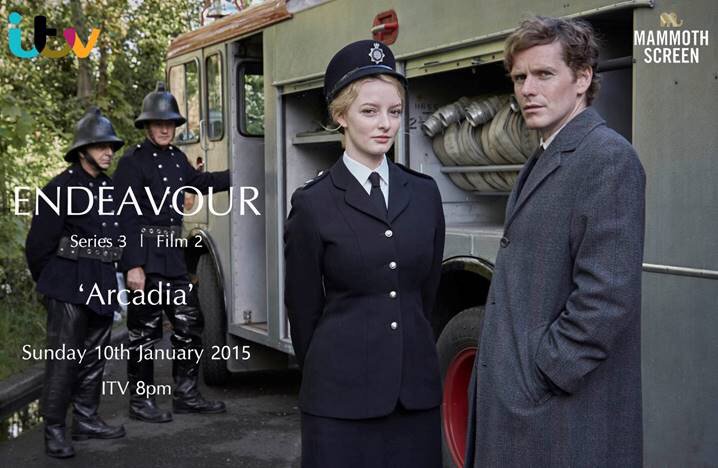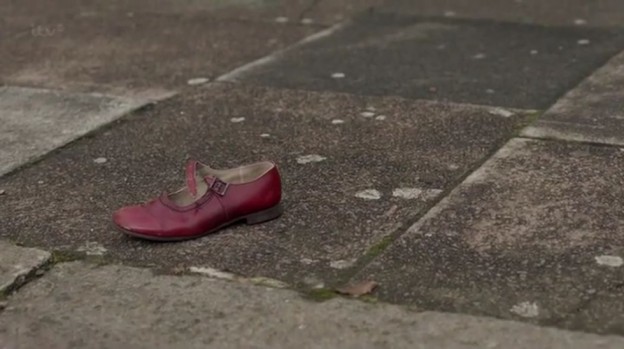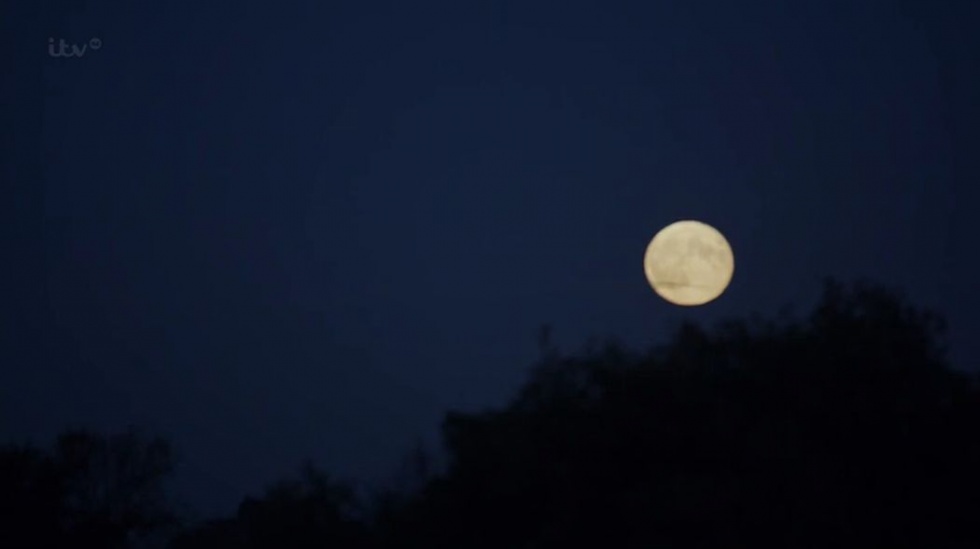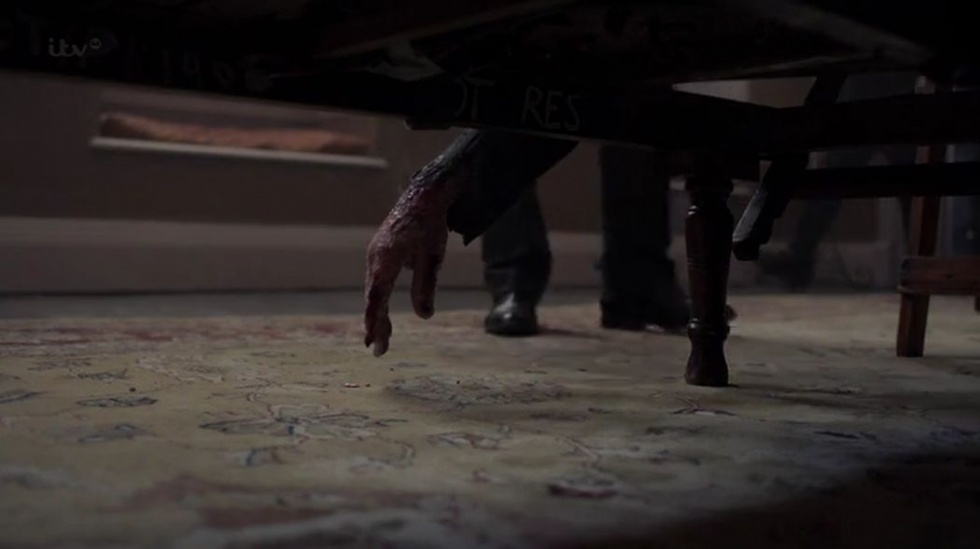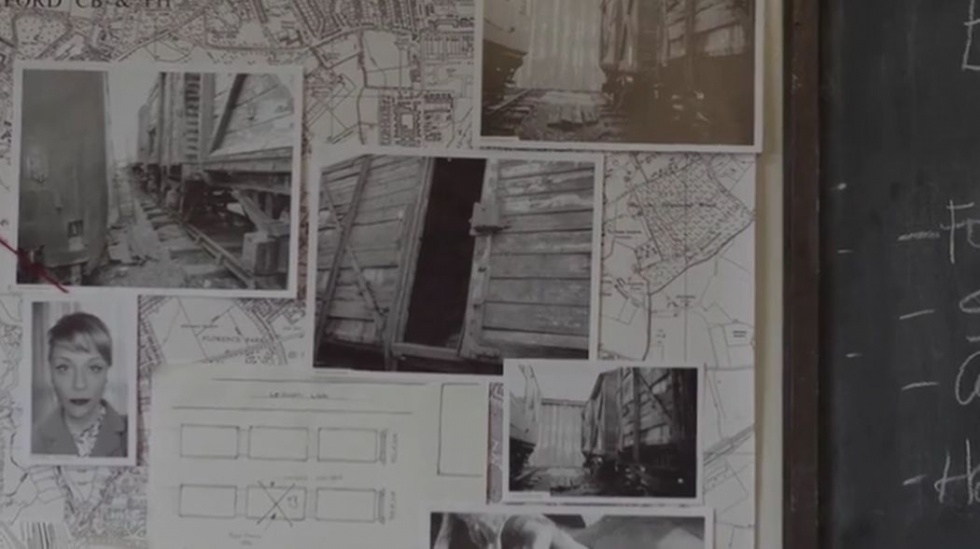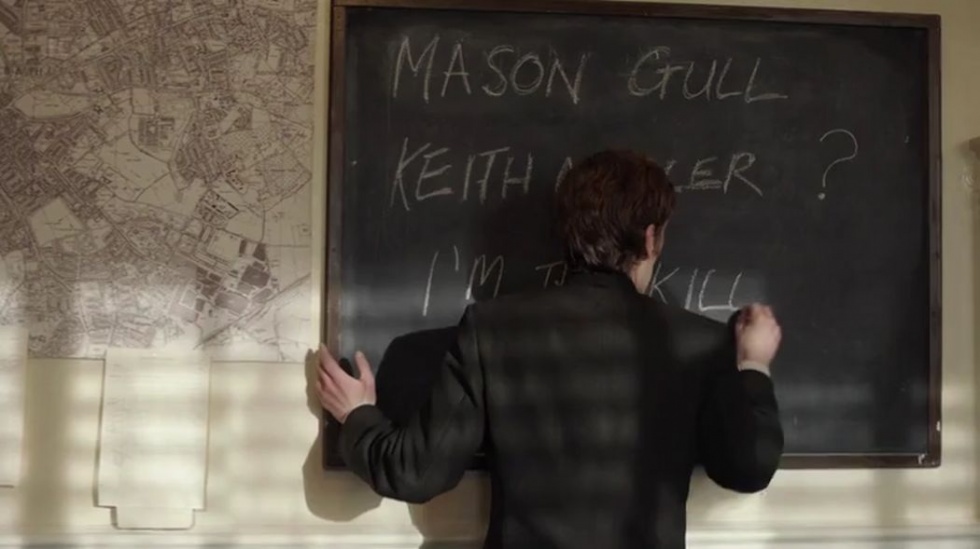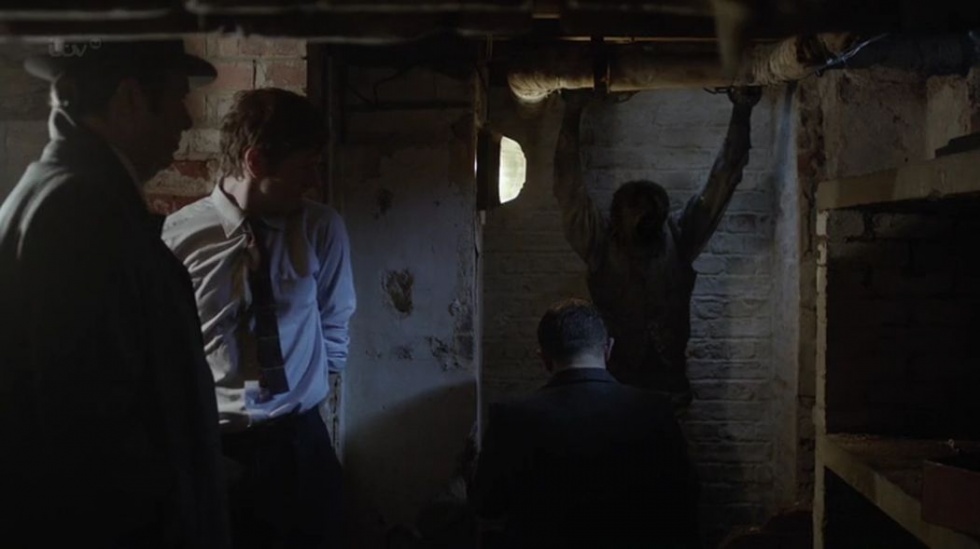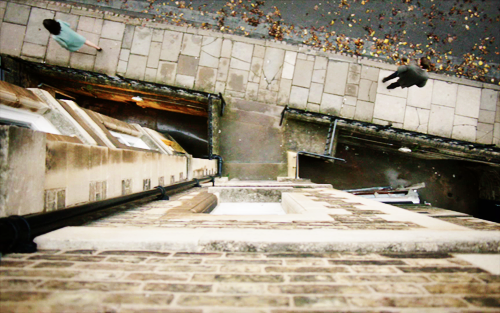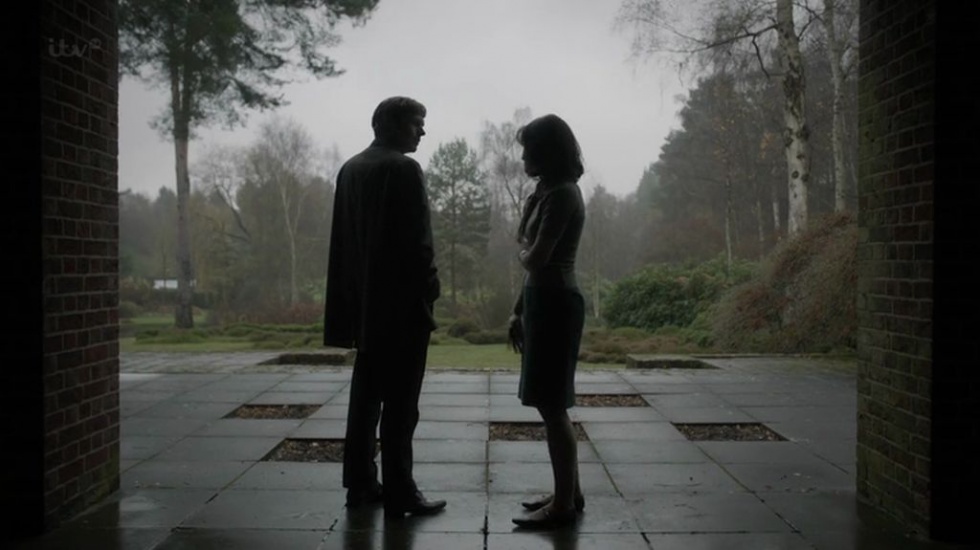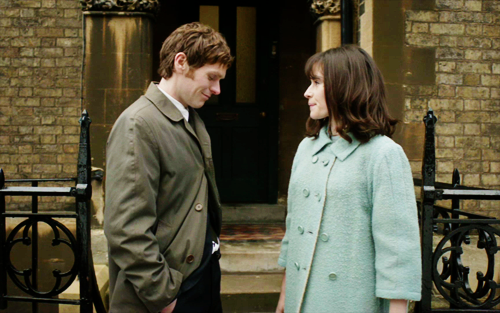THE ENDEAVOUR ARCHIVES #7
Russell Lewis
An exclusive interview
by Damian Michael Barcroft
~
With thanks to Hilary Bray
Camille Pleyel
and Wynnie Stoan
~
SO, last week I was telling you about the eleventh day of shooting and the first on location in Oxford for Series 3 – Film 1: RIDE. You’ll forgive me if I didn’t go into too much detail for fear of spoilers but I hope to rectify that now the episode has been broadcast.
Radcliffe Square was the first of the day’s three location shoots. Rehearsals and sound checks etc. were all well underway by the time I got there at 08:22. Remarkably, considering the scene only lasts just over two minutes in the final cut that you will have seen last Sunday, it took until 10:43 to get the required footage. But then, despite the promise of spring (12 April 2015), it was bloody cold and windy – so much so that they had to stop filming because Shaun’s eyes were watering. Indeed, I don’t think I ever expected to see Endeavour Morse jogging on the spot outside the Bodleian to keep warm.
However, in addition to the weather, cast and crew had to contend with various obstacles including unruly cyclists and a particularly angry delivery man – all determined on making a cameo appearance. It is testament to the good natured family atmosphere enjoyed by both cast and crew that they all remained so humorous and patient – although, since I’m posting this on a Sunday, I won’t reveal what Roger said when confronted by a group of snap-happy tourists hell-bent on a selfie or two.
Needless to say, a lot of cheese and pickle sandwiches were eaten that morning. Anyway, more of this later. I’ve also included a full transcript of the scene in question at the end of the following interview as there is a particularly lovely moment between Endeavour and Thursday which was sadly cut from the final edit. For now though, here’s the second part of an exclusive interview as we continue to explore series two while offering the odd glimpse of tonight’s film…
NOCTURNE
DAMIAN: As with FUGUE (S1:02), the second film of series two also happens to be a horror/thriller story. Will tonight’s film ARCADIA continue the trend for series three?
RUSS: The short answer is no. There was a request to shake the Selection Box a little this time out — so that we didn’t get too predictable. There is an ‘ENDEAVOUR does… (insert genre here)’ film amongst the four, but we have swapped the order around a little.
 DAMIAN: We talked about your love of horror in one of our interviews last year and there are so many references again in NOCTURNE but would it be fair to say that THE INNOCENTS (1961), the work of M. R. James’ and the seventies GHOST STORIES FOR CHRISTMAS were particular inspirations for the mood and tone of this film?
DAMIAN: We talked about your love of horror in one of our interviews last year and there are so many references again in NOCTURNE but would it be fair to say that THE INNOCENTS (1961), the work of M. R. James’ and the seventies GHOST STORIES FOR CHRISTMAS were particular inspirations for the mood and tone of this film?
RUSS: All of those things. PICNIC AT HANGING ROCK came up a bit too — in my discussions with the Director, such as they were.
 DAMIAN: While we were doing our interview prior to the broadcast of NOCTURNE, you mentioned that the actual backstory regarding the Victorian murders sprang from a loose personal connection with the murder of Francis Saville Kent and an affectionate tribute to Dan McCulloch (producer of series one), could you elaborate on this please?
DAMIAN: While we were doing our interview prior to the broadcast of NOCTURNE, you mentioned that the actual backstory regarding the Victorian murders sprang from a loose personal connection with the murder of Francis Saville Kent and an affectionate tribute to Dan McCulloch (producer of series one), could you elaborate on this please?
RUSS: In the late 70s, I worked on a BBC dramatisation of the Constance Kent case which was shot in the West Country – as near as damn it to the original locations. If I remember right – the cast had an anniversary supper – on the evening of the murder.
I suppose we were down there two to three months — across the summer. Staying in various hotels. One in the Quantocks had a touch of Fawlty Towers about it. Not in the service – but in the 70s atmos. Public telephone in the hallway – with a ‘hood’ for privacy! This was an England where a glass of orange juice was often offered as a ‘Starter’.
Fawlty Towers’ ‘The Wedding Party’ with the flirty French guest who goes out in an evening to sample the delights of Torquay..? Mad, but there’s something about the still, summer-night blackness beyond the entrance that absolutely nails what this hotel was like.
One of the locations we used was a house owned by a Headmaster at some school or other — I can’t remember where exactly — and, though a much smaller building, that had a feel of Shrive Hill House. While the crew were filming outside, I had an explore of the servants’ quarters and attic. It stuck in my head, and provided the jumping off point for Endeavour exploring the upper floors of Blythe Mount.
The tribute to Dan… Well, he’s a Home Counties boy — and Dorking has some very pertinent personal associations for him. It was a tease — the notion that he might end his days a hopeless rummy in a rooming house there. In truth, I can think of no future for him that would be less likely.
 DAMIAN: Morse tells us that “this place [Shrive Hill House/Blythe Mount School for Girls] is like a honeycomb; backstairs and concealed corridors…” which instantly reminded me of Poe, particularly the Corman film version of The Fall of the House of Usher (1960). While there’s an abundance of gothic elements and nods to the genre (note the Hammer Horror double-bill that gives Strange “the proper willies”) in some of your scripts, I thought that NOCTURNE, unlike FUGUE, was similar to The Hound of the Baskervilles in that it takes a detective famous for their logic and deductive reasoning and places them in an apparently supernatural setting which almost stretches the conventions of Morse to bursting point. While I, and I’m sure other “connoisseurs of the macabre”, loved every moment, were there any concerns that the audience might find it a little too Scooby-Doo?
DAMIAN: Morse tells us that “this place [Shrive Hill House/Blythe Mount School for Girls] is like a honeycomb; backstairs and concealed corridors…” which instantly reminded me of Poe, particularly the Corman film version of The Fall of the House of Usher (1960). While there’s an abundance of gothic elements and nods to the genre (note the Hammer Horror double-bill that gives Strange “the proper willies”) in some of your scripts, I thought that NOCTURNE, unlike FUGUE, was similar to The Hound of the Baskervilles in that it takes a detective famous for their logic and deductive reasoning and places them in an apparently supernatural setting which almost stretches the conventions of Morse to bursting point. While I, and I’m sure other “connoisseurs of the macabre”, loved every moment, were there any concerns that the audience might find it a little too Scooby-Doo?
RUSS: I suppose it may have been a stretch for some, but I hoped we’d built up enough trust with the audience over the preceding films that they’d go with us. Probably just me trying to have my penny and my bun. But – for all the ghostly bells and whistles — we did try to play fair by the rules of the whodunit.
It’s interesting that you reference The Fall of the House of Usher. Though Blythe Mount didn’t crumble into the tarn, in the original, early drafts of NOCTURNE, the school went up a raging blaze – Endeavour hunting for Bunty and the killer through the smoke and flames; an ending like so many Hammer Horrors – but, the director wasn’t keen. So…
 DAMIAN: Who is your favourite screen Sherlock Holmes by the way?
DAMIAN: Who is your favourite screen Sherlock Holmes by the way?
RUSS: Oh – that’s hard. Benedict Cumberbatch is doing great work, of course. A Sherlock for the 21st century. Modern and thrilling.
Perhaps it’s like the Doctor – every generation has its own Sherlock. For someone of my years… Jeremy Brett is hard to trump. One of Paget’s illustrations sprung to life. I did see him and Edward Hardwicke do The Secret of Sherlock Holmes on stage, which was rather wonderful. But I remember when the first of the series went to air – JB’s brilliance notwithstanding, it was David Burke’s Watson that was the real great leap forward. They redefined the relationship – after decades of a kind of ‘received’ performance from the what-what-what? school of Watson, David Burke restored his dignity.
Basil Rathbone was the Sherlock I grew up with as a kid, with the movies on re-run, so I’ve a great fondness for his portrayal. That would have been the first Sherlock that properly registered with me. Peter Cushing was terrific.
Blasphemous, perhaps, so say it softly, but I thought Robert Downey Jnr & Jude Law made a pretty decent fist of it in the two Guy Richie movies. Jared Harris was a corking Moriarty. And Eddie Marsan’s Lestrade… On screen for all too brief a time, but not a second of it wasted. But then Eddie Marsan’s work always has such integrity. I don’t think he’s ever played a false moment. You know – like Edmund Reid, or Fred Abberline – one didn’t become a Detective Inspector in Late Victorian London by being dull-witted. I think you really feel that with Eddie Marsan’s portrayal. That he could handle himself – intellectually and physically.
Nicol Williamson was interesting in The Seven Per Cent Solution, but a bit of a stressful watch. Hard to take your eyes off Alan Arkin’s Sigmund Freud, though. Hard to take your eyes off Alan Arkin in anything. Weirdly enough – it was Arkin’s turn in ‘Wait Until Dark’ I had in mind for the photographer in TROVE. That sort of Paul Simon ‘do’? A sort of… French Crop, is it? But, sadly – the look fell by the wayside.
However… ‘favourite’ Holmes… I have a very special place in my heart for Christopher Plummer’s turn in Murder By Decree. James Mason also gives a hugely entertaining old school Watson. ‘You squashed my pea!’
Of course, like From Hell — it shadows the late Stephen Knight’s now much discredited hypothesis. But the yarn spun, and the supporting cast… Frank Finlay’s Lestrade; Donald Sutherland’s Robert Lees; Sir Anthony Quayle, Sir John Gielgud, and a cracking turn by David Hemmings… together with a suitably creepy score and cracking production values, makes for an altogether irresistible two hours. Great opening model shot of London skyline too. If you haven’t seen it… Great fun!
But he’s crime fiction’s answer to Hamlet, isn’t he? It’s quite possible that the greatest Holmes may not have been born yet.
DAMIAN: I loved the moment when the author of “Plighted Cunning: An account of the Blaise-Hamilton murders”, Stephen Fitzowen (splendid Desmond Barrit), bangs on the door of the school and says in a very Lionel Grisbane sort of way, “Good Evening” which I almost expected him to follow with “I have returned…”. Was there a particular model for the character or an actor in mind to play him as you wrote the part?
RUSS: Yeh – Desmond was great. I think the stage direction in the shooting script featured an exterior establishing shot – which was Fitzowen getting out of a taxi, and framed in a halo of light from a lamp by the door – portable recording equipment in hand, standing in for Max Von Sydow’s suitcase. But in the end – for scheduling reasons — this was never shot.
That whole sequence was intended to take place on a dark and stormy night. Thunder. Lightning. If you’re going to embrace the tropes..? All or nothing at all. But, despite my best efforts, I couldn’t convince the director to get behind it. C’est la guerre.
 The character was a nod to Dashiell Hammett’s The Dain Curse – which featured a writer Owen Fitzstephan right at the heart of proceedings. There was an adaptation of this in the 70s with James Coburn as ‘Ham Nash’, the Gumshoe; and everyone’s favourite troubled Jesuit — Jason Miller — as Fitzstephan (which was another happy connection.)
The character was a nod to Dashiell Hammett’s The Dain Curse – which featured a writer Owen Fitzstephan right at the heart of proceedings. There was an adaptation of this in the 70s with James Coburn as ‘Ham Nash’, the Gumshoe; and everyone’s favourite troubled Jesuit — Jason Miller — as Fitzstephan (which was another happy connection.)
My memory is a dented and wonky sieve, but I think Fitzowen was originally several characters; including a trio of academics with an interest in parapsychology. I don’t think I went as far as naming them Venkman, Spengler & Stanz, but that’s certainly what I was drawing on. Just a bit of fun. Seeing how they played out as dramatic characters, rather than comedic ones. Sadly – due to space and budget – they ended up biting the bullet, and some of their material was grafted on to Fitzowen.
 But he was a type, more than anything… A touch of Ronnie Barker’s ‘Magnificent Evans’ in there. Maybe even a bit of Ed Reardon. Some of that… Neil Oliver is it? The TV historian? Some of that Celtic ‘WhooOOOOoo!’ in the delivery. A chap, one suspects, who could invest even the most commonplace occurrence with a suggestion of the fey folk at work or the Gods at dice. I’d love to hear him order breakfast.
But he was a type, more than anything… A touch of Ronnie Barker’s ‘Magnificent Evans’ in there. Maybe even a bit of Ed Reardon. Some of that… Neil Oliver is it? The TV historian? Some of that Celtic ‘WhooOOOOoo!’ in the delivery. A chap, one suspects, who could invest even the most commonplace occurrence with a suggestion of the fey folk at work or the Gods at dice. I’d love to hear him order breakfast.
It was a bit of a pig for poor old Des – especially the magic lantern show, which featured hideous amounts of unadulterated plot-spiel. Lines like that are very difficult to get down – as there’s nothing to play off. No cues. But he did it wonderfully.


 DAMIAN: Once again, this film features a plethora of cultural references including, in addition to those already mentioned, Lewis Carroll, Ian Fleming, Philip Larkin, Charles Perrault, P. G. Wodehouse and John Wyndham to name but a few. At what point do these occur to you, is it through the research and writing stage or do they forever reside within your consciousness rather like Simonides’ method of loci?
DAMIAN: Once again, this film features a plethora of cultural references including, in addition to those already mentioned, Lewis Carroll, Ian Fleming, Philip Larkin, Charles Perrault, P. G. Wodehouse and John Wyndham to name but a few. At what point do these occur to you, is it through the research and writing stage or do they forever reside within your consciousness rather like Simonides’ method of loci?
RUSS: Mostly just flotsam and jetsam swilling around the cloaca maxima that serves for a mind.
DAMIAN: And is Plighted Cunning simply a reference to King Lear and, if so, was this used because of the story, like NOCTURNE, concerns themes of betrayal and justice regarding a father’s fortune?
RUSS: I think – because I was drawing on the Murder at Rode (Road) Hill House – that I was trying to find a title that had an echo of Cruelly Murdered by Bernard Taylor. That and Yseult Bridges’ The Saint With Red Hands – were our two main guidebooks to the case. I think I was just trying to come up with a title that a rather florid character such as Fitzowen might have used, and it seemed to chime. The Queens of the Golden Age plundered Shakespeare, so it felt right and fitting to follow their example. One of those three in the morning decisions that’s hard to accurately recall after such a passage of time.
DAMIAN: I know you’re fond of walking, to what extent have your adventures manifested themselves into your scripts such as the Domesday Book (TROVE) and Holmwood Park Sanitorium (NOCTURNE) for example?
RUSS: Quite a bit, I suppose. You do see some odd things. Long abandoned vehicles in unlikely places. The caravans in NEVERLAND came from one I’d seen in a state of advanced disintegration. It was on a regular route – and, over a couple of years, I just watched this thing gradually disappear. Actually, when I first saw it, the caravan looked rather like the mobile home at the start of THEM! Torn open. Thankfully no fifteen foot ants came whiffling out of the tulgey wood. But yes – I’m a sucker for the atmosphere of such places.
Holmwood Park first put in an appearance in LEWIS – Falling Darkness – and it seemed fun to fold it back into ENDEAVOUR in some way. I think I read somewhere, or someone told me, about a place like Holmwood Park, not too far from Oxford, where undergrads that had burnt-out sometimes ended up. A kind of proto-Priory. Quite a lot of derelict medical facilities out there. Nature reclaiming buildings. Creeping decay. Ruin. Damp. Fungi. And there’s definitely a sense of frozen in aspic about some of them. Time stopped. Some of the larger sites – the staff social areas – clubs and canteens. Press your nose up against the window and you can see cabinets still filled with old Darts trophies – shields and cups. Round Robin Tennis fixtures – decades out of date. Fantastic.
DAMIAN: There are close-ups of “Plighted Cunning” in NOCTURNE and we regularly see various shots of articles and clippings from The Oxford Mail. Given their detail and relevance to the plots, who actually writes these?
RUSS: Sam Costin creates the text for these – and he’s an absolute genius at it.

 DAMIAN: Where are all the props such as Plighted Cunning and the autographed Rosalind Calloway LP (from FIRST BUS TO WOODSTOCK) stored?
DAMIAN: Where are all the props such as Plighted Cunning and the autographed Rosalind Calloway LP (from FIRST BUS TO WOODSTOCK) stored?
RUSS: In various prop-houses and storage facilities.
DAMIAN: How was Chopin’s Nocturne chosen?
RUSS: It’s a favourite. They’re all terrific, but something about the one we went with seemed to my ear even more eerie than its fellows. And I thought if we could put that on a musical box…
DAMIAN: We talked about film noir last week so I was intrigued to discover there is actually a 1946 George Raft movie in that genre called Nocturne! – were you aware of this or is it just a coincidence?
RUSS: It is just a coincidence.
DAMIAN: There are some lovely moments between Morse and Joan Thursday (Sara Vickers) and there has been an obvious attraction and chemistry between the two since the first series. Wouldn’t it be wonderful to see them destined for a bit of slap and tickle or perhaps I should say a bit of how’s your father?
RUSS: It’s an interesting relationship. And the chemistry is rather lovely to watch. I do know exactly how it’s going to evolve, but more than that… I can’t say.
 DAMIAN: Another scene which I adore was between Morse and Max after the young girl Maud Ashenden is murdered. Max says to Morse, “Adults, one takes the rough with the smooth. But this… you find this piece of work, Morse. You find whoever did that. For me, all right? You find them…”. An absolutely beautiful moment in which Morse expresses sympathy but also genuine surprise at Max’s unusual lamentation for a corpse. Was this purely because it was a child’s death or were there possibly hints that there might be other reasons that it resonated with Max to such an extent?
DAMIAN: Another scene which I adore was between Morse and Max after the young girl Maud Ashenden is murdered. Max says to Morse, “Adults, one takes the rough with the smooth. But this… you find this piece of work, Morse. You find whoever did that. For me, all right? You find them…”. An absolutely beautiful moment in which Morse expresses sympathy but also genuine surprise at Max’s unusual lamentation for a corpse. Was this purely because it was a child’s death or were there possibly hints that there might be other reasons that it resonated with Max to such an extent?
RUSS: I thought it would be nice to see another side of Max. The typically sanguine and unflappable pathologist undone by the brutal ruin wrought upon poor Maudie. And Jimmy Bradshaw played it – as always — to perfection. I don’t have a lot of room to cast as much light as I’d like to upon those most intimately involved with Endeavour – mainly for reasons of time, and the demands of unspooling the plot, but I hope I can give some clues here and there as to what makes them tick. Nice for the actors to have something to play, rather than simply offering ‘just the facts, ma’am.’
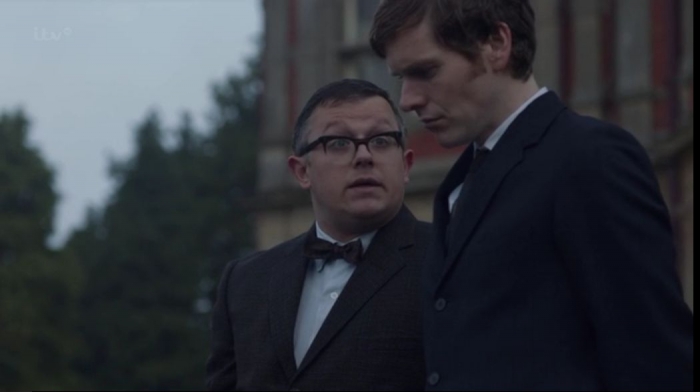 DAMIAN: In the absence of you actually telling us anything about tonight’s film ARCADIA, can you please say something clever and cryptic instead?
DAMIAN: In the absence of you actually telling us anything about tonight’s film ARCADIA, can you please say something clever and cryptic instead?
RUSS: Well, we’ve done the Manufactory; the Department Store; and so this is – to some small degree – our ‘Ladybird Book of the Supermarket.’ A key player from Morse’s later adventures puts in an appearance. And we touch on Endeavour’s childhood connection to Quakerism. One door opens…
101. EXT. OXFORD LOCATION PARK BENCH [Radcliffe Square] – DAY 5
ENDEAVOUR and THURSDAY.
ENDEAVOUR: Didn’t you say that was Harry Rose’s business?
THURSDAY: Slots? In part. Harry Rose has been at it since the Devil was in short trousers. Oh — and it’s definitely Bixby by the way. Dr.deBryn was able to match his prints to a number of latents taken from the house. (digs out sandwiches) Right.
ENDEAVOUR: You’ve seen them? Cheese and pickle. The Belboroughs?
THURSDAY: All bar the tennis player. She stayed at the Randolph. The rest haven’t got a decent alibi between them for Bixby. Though your mate Anthony Donn says he was with Belborough the night Jeannie was killed. (a moment) You really think there’s a connection between Harry Rose and this bloke at the shooting gallery?
ENDEAVOUR: Maybe. I don’t know. I’m just stumbling around.
THURSDAY: What you’re good at.
THURSDAY eats his sandwich – watches the world go by.
ENDEAVOUR: The first week I hardly slept. I didn’t know if I was going to be found hanged from the bars of the cell, or take a dive from the top walk. (off Thursday) Every night I expected to hear boots on the landing – the key in the lock – but nobody came by. A month. I didn’t know if you were alive or dead. That was the worst of it. No. Not quite. The worst was… Knowing it was my fault.
THURSDAY — appalled.
ENDEAVOUR: (CONT’D) I was too slow. My stupidity nearly left Mrs.Thursday a widow, and…
The thought is too much for him.
THURSDAY: I knew walking in to Blenheim Vale that I might not walk out. (That’s) The job, I suppose. Something bad like that? Sometimes you’ve to put all you are against all they’ve got. It was my decision. And I’d do it again without a second thought. Don’t ever blame yourself.
ENDEAVOUR: If I’d been quicker off the mark…
THURSDAY: You were there at the end. Nobody else. You had the chance to run. To look to your own neck. But you didn’t. You stood. A pinch like that, it’s not brain that counts. It’s guts. I won’t forget it. Ever. (a moment) You should eat something. You don’t eat enough. Here.
THURSDAY offers the other half of his sandwich. A moment — ENDEAVOUR takes it. Just two men, sharing a sandwich.
Interview and photos copyright © Damian Michael Barcroft 2016
All other images copyright © itv/Mammoth Screen


